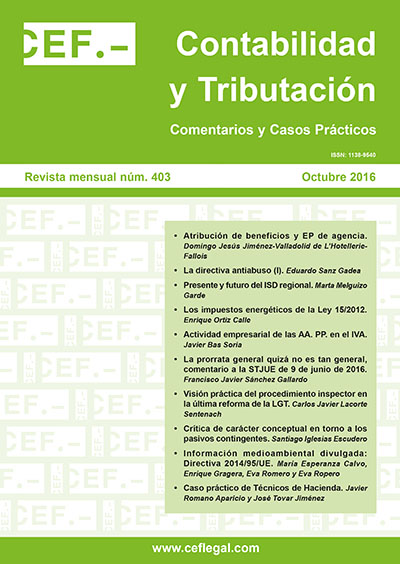La atribución de beneficios al establecimiento permanente de agencia: ¿una reconsideración del criterio arm's lenght?
DOI:
https://doi.org/10.51302/rcyt.2016.4749Palabras clave:
establecimiento permanente de agencia, atribución de beneficios, agente dependienteResumen
Este trabajo ha obtenido un Accésit del Premio Estudios Financieros 2016 en la modalidad de Tributación.
La figura del establecimiento permanente de agencia es una de las más conflictivas en el ámbito de la fiscalidad internacional por las disparidades en su interpretación entre los distintos Estados. Mediante esta figura se considera que una empresa no residente dispone de un establecimiento permanente en un Estado como consecuencia de las actividades de un agente. En el marco del Plan BEPS esta figura ha sufrido un cambio dramático, encaminado a disminuir el umbral necesario para que las actividades de un intermediario puedan ser consideradas como constitutivas de un establecimiento permanente en el Estado de la fuente. Sin embargo, la existencia de un establecimiento permanente es únicamente la primera fase para que se puedan gravar los beneficios empresariales obtenidos por una empresa no residente, ya que, a continuación, deben atribuírsele beneficios. De acuerdo con las directrices de la OCDE, la atribución de beneficios se basa en el denominado enfoque autorizado, que supone la aplicación analógica de las directrices sobre precios de transferencia a las relaciones entre establecimiento permanente y casa central. Sin embargo, en el caso del establecimiento permanente de agencia, la aplicación de estas directrices se antoja complicada, planteándose en el presente trabajo varias alternativas para poder atribuir beneficios a esta clase de establecimientos permanentes.
Descargas
Citas
Avery Jones, J. F. y Lüdicke, J. [2014]: «The origins of article 5(5) and 5(6) of the OECD Model», World Tax Journal, vol. 6, núm. 3.
Calderón Carrero, J. M. [2014]: «Beneficios empresariales (y de navegación)», en Carmona Fernández, N. (coord.), Convenios fiscales internacionales y fiscalidad de la Unión Europea 2014, CISS, Valencia.
Carmona Fernández, N. [2012]: «La noción de establecimiento permanente en los tribunales: las estructuras operativas mediante filiales comisionistas», Crónica tributaria, núm. 145.
Comisión Europea [2011]: Propuesta de Directiva del Consejo relativa a una base imponible consolidada común del impuesto sobre sociedades (BICCIS), COM(2011) 121 final.
Dziurdź, K. [2014]: «Attribution of Functions and Profits to a Dependent Agent PE: Different Arm's Length Principles under Articles 7(2) and 9?», World Tax Journal, vol. 6, núm. 2.
Fernández Gregoraci, B. [2008]: «Representación directa e indirecta: definición y efectos conforme al DCFR y a los PECL», Indret, núm. 4.
Martín Jiménez, A. [2014]: «Preventing the Artificial Avoidance of PE Status», Papers on Selected Topics in Protecting the Tax Base of Developing Countries, United Nations, New York.
Moshammer, H. y Tumpel, M. [2014]: «Attribution of Profits to a Dependent Agent PE», en Lang, M. et al. (eds.), Dependent Agents as Permanent Establishments, Linde, Viena.
OCDE [2010]: Report on the Attribution of Profits to Permanent Establishments, OECD Publishing, Paris.
– [2010]: Transfer Pricing Guidelines for Multinational Enterprises and Tax Administrations, OECD Publishing, Paris.
– [2013]: Action Plan on Base Erosion and Profit Shifting, OECD Publishing, Paris.
– [2015]: Preventing the Artificial Avoidance of Permanent Establishment Status, Action 7 - 2015 Final Report. OECD/G20 Base Erosion and Profit Shifting Project, OECD Publishing, Paris.
– [2015]: Addressing the Tax Challenges or the Digital Economy, Action 1 – 2015 Final Report, OECD/G20 Base Erosion and Profit Shifting Project, OECD Publishing, Paris.
– [2015]: Aligning Transfer Pricing Outcomes with Value Creation. Actions 8-10 – 2015 Final Reports, OECD/G20 Base Erosion and Profit Shifting Project, OECD Publishing, Paris.
Oyama, H. [2014]: «Countering BEPS: Preventing Abusive Commissionaire Arrangements», Tax Notes International, vol. 75, núm. 13.
Pijl, H. [2013]: «Agency permanent establishments: in the name of and the relationship between Article 5(5) and (6) - part 1», Bulletin for international taxation, vol. 67, núm. 1.
– [2013]: «Agency permanent establishments: in the name of and the relationship between Article 5(5) and (6) - part 2», Bulletin for international taxation, vol. 67, núm. 2.
Vega Borrego, F. A. [2003]: Las Medidas contra el «Treaty Shopping», Instituto de Estudios Fiscales, Madrid.
Zielke, R. [2012]: «Commissionaire Structure as an Agency Permanent Establishment (PE): Low Risk for Foreign Principals Constituting a PE in Norway – Dell Products v. Government of Norway, Decision of the Norwegian Supreme Court of 2 December 2011», Intertax, vol. 40, núm. 8/9.
Zornoza Pérez, J. y Báez Moreno, A. [2015]: «La Cláusula de EP Frente al Tratamiento de las Reestructuraciones Empresariales: Los casos Roche y Dell», en Uehara Hashimoto, Y. (coord.), Temas selectos de precios de transferencia, Themis-IFA, México.
















